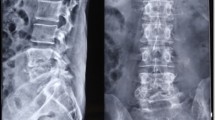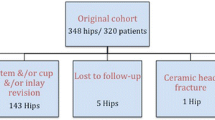Summary
Between 1987 and 1991 the spine was stabilised in 205 patients using corundum ceramic implants. The radiological results were assessed with a follow up of from 6 to 24 months and were graded as good in 81%. Poor results were not due to the implanted material, but were usually caused by failure to obtain full correction of the deformity at operation. Porous ceramic implants produce better radiological results, with a decrease in operating time and a reduced risk of infection.
Résumé
Cet article présente l'analyse des résultats radiologiques obtenus chez 205 malades opérés d'Octobre 1987 à Décembre 1991 au Centre Métropolitain de Rééducation de Konstancin. Pour obtenir la stabilisation des fractures du rachis, nous avons utilisé des implants de céramique produits par l'Ecole Polytechnique de Wroclaw. L'évaluation des résultats radiologiques, de 6 mois à 2 ans après l'opération, montre que ceux-ci sont favorables dans la majorité des cas (81%). Les mauvais résultats ne sont pas dus à la qualité du matériel implanté mais le plus souvent à l'impossibilite d'obtenir une réduction chirurgicale complète de la déformation du rachis. Les auteurs concluent de leur expérience que les implants de céramique ont un intérêt clinique indiscutable. Leur utilisation permet une amélioration des résultats radiologiques, une réduction de la durée de l'intervention ainsi qu'une diminution du risque d'infection post-opératoire.
Similar content being viewed by others
References
Bieniek J, Michalska G, Swięki Z, Buczek A (1979) Evaluation of structure and microstructure of nonorganic substance of the bone tissue. Chir Narz Ruchu Ortop Pol 44: 573–575
Bieniek J, Swięcki Z, Rosiek G, Buczek A (1983) Biological conformity of porous ceramic material. Chir Narz Ruchu Ortop Pol 48: 363–367 (Engl abstr)
Bieniek J, Swięcki Z, Rosiek G (1986) Porose Korundkeramik als Biomaterial. Z Orthop 124: 533–537
Bieniek J, Swięcki Z (1991) Porous and porous-compact ceramics in orthopaedics. Clin Orthop 272: 88–94
Cloward RB (1963) Lesions of the intervertebral discs and their treatment by interbody fusion methods. Clin Orthop 27: 51–77
Haftek J, Rudnicki Sz, Kiwerski J (1968) Acute trauma of the cervical segment of the spinal cord. In: M. Weiss (ed) Compensation of the spinal cord function. PZWL, Warsaw, pp 75–86
Kiwerski J, Weiss M (1980) Neurological improvement in traumatic injuries of the cervical spine. Paraplegia 18: 31–37
Kiwerski J (1982) Anterior interbody fusion in treatment of cervical spine traumas. Intern Orthop 6: 255–258
Kiwerski J, Krasuski M (1989) The use of porous ceramic implants in surgery of the spine (preliminary report). Chir Narz Ruchu Ortop Pol 54: 181–187
Kiwerski J (1991) Anterior operations in cervicarthrosis and vertebral artery compression. Clin Orthop 272: 95–99
Author information
Authors and Affiliations
Rights and permissions
About this article
Cite this article
Kiwerski, J.E., Ogonowski, A., Bieniek, J. et al. The use of porous corundum ceramics in spinal surgery. International Orthopaedics 18, 10–13 (1994). https://doi.org/10.1007/BF00180170
Accepted:
Issue Date:
DOI: https://doi.org/10.1007/BF00180170




